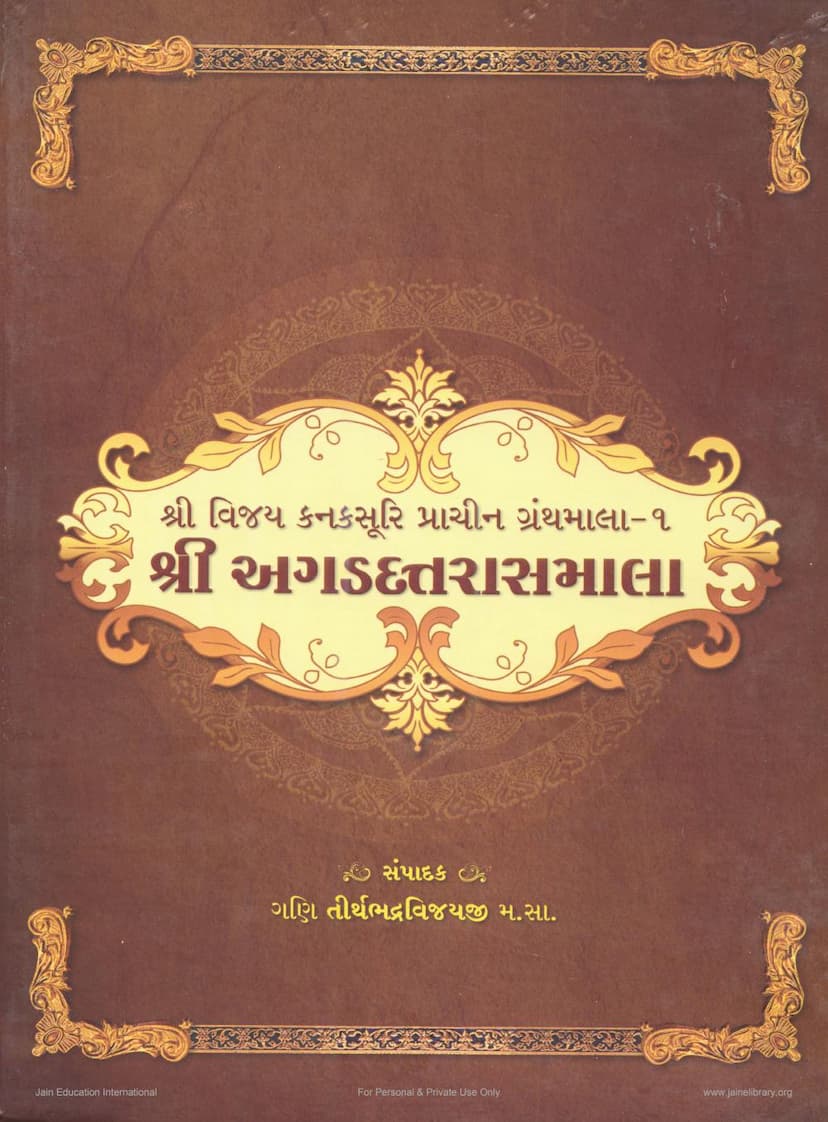Agaddatta Rasmala
Added to library: September 1, 2025
Loading image...

Summary
This Jain text, titled "Agaddatta Rasmala," compiled by Ganivarya Shri Tirthbhadravijayji, and published by Shri Shraman Seva Religious Trust, presents a collection of rasas (poetic narratives) based on the story of Agadadatta.
Here's a comprehensive summary of the provided pages:
Book Details and Acknowledgements:
- Title: Agaddatta Rasmala (શ્રી અગડતાસમાલા)
- Author/Compiler: Ganivarya Shri Tirthbhadravijayji (ગણિ તીર્થભદ્રવિજયજી મ.સા.)
- Publisher: Shri Shraman Seva Religious Trust, Dhrangadhra (શ્રી શ્રમણ સેવા રીલીજીયસ ટ્રસ્ટ, ધ્રાંગધ્રા)
- Publication Year: Samvat 2069 (Vikram era), corresponding to 2013 CE.
- Inspiration/Dedication: The book is published in commemoration of the 50th Vargavahan Varsha (anniversary of ascension to heaven) of Param Pujya Acharya Devesh Shrimad Vijay Kanaksurishwarji Mahasattva (પરમ પૂજ્ય આચાર્ય દેવેશ શ્રીમદ્ વિજય કનકસૂરીશ્વરજી મ. સા.). The "Shri Vijay Kanaksuri Prachin Granthamala" (શ્રી વિજય કનકસૂરી પ્રાચીન ગ્રંથમાલા) was initiated for his permanent remembrance.
- Gratitude: The publishers express deep gratitude to Acharya Devesh Shrimad Vijay Kalapurnasurishwarji Mahasattva, Acharya Bhagwant Shrimad Vijay Kalaprabhasurishwarji Mahasattva, Acharya Dev Shrimad Vijay Kalpatrusurishwarji Mahasattva, and Sadvi Dhairyabhadra Shri Ji Mahasattva for their divine blessings and guidance. Special thanks are given to Shri Bhachau Visha Oshwal Shvetambar Murjapujak Jain Sangh for sponsoring the publication of the first book in the Granthamala series. Thanks are also extended to Shri Amar Gada for his support, and to all who contributed in small or large ways to the publication.
Content and Purpose:
- Revival of Ancient Literature: The primary aim of this compilation is to bring to light and present to the world the rich and often unpublished rasa literature in Jain Gujarati literature, specifically focusing on the story of Agadadatta. Many such rasas and choupais (poetic verses) have remained unprinted until now.
- Educational Value: The compilation aims to make the profound teachings of Jain scriptures accessible to the general public, especially children, through the dharma kathanuyoga (narrative aspect of religious teachings). The story of Agadadatta, being an ancient and famous Jain narrative, is presented in various forms to facilitate understanding.
- Scholarly Approach: The compiler, Shri Tirthbhadravijayji, along with his disciples, has undertaken the task of gathering and compiling various ancient works on the Agadadatta story. The effort involves transliterating and presenting these often-unpublished manuscripts. The work includes a comparative analysis of different versions, highlighting their unique aspects.
- Agadadatta Katha: The text delves into the Agadadatta Katha (the story of Agadadatta), which is said to have originated in the Vasu-dev-hindi around the 6th century Vikram era. The story exists in two main streams of tradition, one based on Vasu-dev-hindi and the other on the commentary of Nemichandrasuri on the Uttaradhyayana Sutra. The introduction traces the lineage of Agadadatta's story through various Jain texts and commentaries, noting variations and sources.
- Highlighting Gujarati Jain Literature: The compilation serves to showcase the extensive literary output in the Gujarati language during the medieval period (circa 14th to 18th century CE), produced by Jain monks and laymen. This literature, often in the form of stutis, sajhays, stavans, rasas, choupais, etc., served as a means to convey scriptural knowledge in an accessible manner to the common people.
- Comprehensive Analysis: The "Pithbandh" (a preliminary section) includes detailed sections on:
- Agadadatta Katha - Anusandhan: An exploration and tracing of the Agadadatta story across various sources.
- Prakashit thai rahela krutio no parichay: An introduction to the published works within this collection.
- Tulnatmak Sampreshan: A comparative analysis of the different rasas and their variations.
- Hastiprat Parichay: A description of the manuscripts used in the compilation.
- Patha Sampadan Paddhati: The methodology employed in editing and presenting the texts.
- Specific Rasas Included: The book presents multiple rasas and choupais on the Agadadatta story, attributed to various authors like Sumatimuni, Kushallabhji, Shrisundarji, Gunvinayji, Lalitkirti ji, Sthansagarji, Nandlalji, Punyanidhanji, Bhim (a layman), Shantasaubhagyaji, and Man/Mahimasinhji. Each section often includes details about the manuscript, its age, and its unique features.
- Linguistic and Literary Features: The introduction discusses the evolution of Jain literature in Gujarati, the use of various poetic forms, and the rich metaphorical language and descriptive elements employed by the poets. It highlights the effort to preserve and present this ancient literature in its original form while ensuring readability.
Key Themes and Narratives within the Agadadatta Story (as indicated in the excerpts):
- The story of Agadadatta: This central narrative seems to revolve around Agadadatta, who, after a life of indulgence and societal misconduct, undergoes a transformation and ultimately attains spiritual liberation.
- The role of Gurus: The influence and guidance of spiritual teachers (gurus, upadhyays) in the lives of individuals, including Agadadatta, is a recurring theme.
- Moral and Ethical Teachings: The narratives aim to convey moral lessons about the consequences of actions, the importance of virtue, the fleeting nature of worldly pleasures, and the path to spiritual upliftment.
- Literary Devices: The various rasas extensively use poetic devices like similes (upama), metaphors (roopak), exaggerations (atishayokti), and illustrative examples (drishtanta) to make the stories engaging and impactful.
- Preservation of Shrut (Scriptural Knowledge): The overall effort is a testament to the dedication towards preserving and disseminating the rich heritage of Jain knowledge through literature.
This comprehensive summary draws from the provided pages, focusing on the organizational structure, authorial intent, and the content highlights of the "Agaddatta Rasmala."